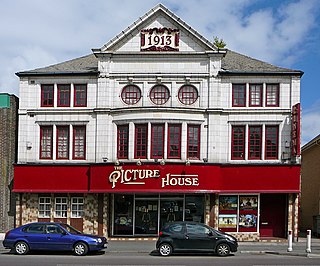
Widescreen images are displayed within a set of aspect ratios used in film, television and computer screens. In film, a widescreen film is any film image with a width-to-height aspect ratio greater than the standard 1.37:1 Academy aspect ratio provided by 35 mm film.

70 mm film is a wide high-resolution film gauge for motion picture photography, with negative area nearly 3.5 times as large as the standard 35 mm motion picture film format. As used in cameras, the film is 65 mm (2.6 in) wide. For projection, the original 65 mm film is printed on 70 mm (2.8 in) film. The additional 5 mm are for four magnetic strips holding six tracks of stereophonic sound. Although later 70 mm prints use digital sound encoding, the vast majority of existing and surviving 70 mm prints pre-date this technology.

IMAX is a proprietary system of high-resolution cameras, film formats, film projectors, and theaters known for having very large screens with a tall aspect ratio and steep stadium seating.

The National Science and Media Museum, located in Bradford, West Yorkshire, is part of the national Science Museum Group in the UK. The museum has seven floors of galleries with permanent exhibitions focusing on photography, television, animation, videogaming, the Internet and the scientific principles behind light and colour. It also hosts temporary exhibitions and maintains a collection of 3.5 million pieces in its research facility.

CinemaScope is an anamorphic lens series used, from 1953 to 1967, and less often later, for shooting widescreen films that, crucially, could be screened in theatres using existing equipment, albeit with a lens adapter. Its creation in 1953 by Spyros P. Skouras, the president of 20th Century Fox, marked the beginning of the modern anamorphic format in both principal 2.55:1, almost twice as wide as the previously common Academy format's 1.37:1 ratio. Although the technology behind the CinemaScope lens system was made obsolete by later developments, primarily advanced by Panavision, CinemaScope's anamorphic format has continued to this day. In film-industry jargon, the shortened form, 'Scope, is still widely used by both filmmakers and projectionists, although today it generally refers to any 2.35:1, 2.39:1, 2.40:1, or 2.55:1 presentation or, sometimes, the use of anamorphic lensing or projection in general. Bausch & Lomb won a 1954 Oscar for its development of the CinemaScope lens.

Cinerama is a widescreen process that originally projected images simultaneously from three synchronized 35mm projectors onto a huge, deeply curved screen, subtending 146° of arc. The trademarked process was marketed by the Cinerama corporation. It was the first of a number of novel processes introduced during the 1950s, when the movie industry was reacting to competition from television. Cinerama was presented to the public as a theatrical event, with reserved seating and printed programs, and audience members often dressed in their best attire for the evening.

Pacific Theatres' Cinerama Dome is a movie theater located at 6360 Sunset Boulevard in Hollywood, California. Designed to exhibit widescreen Cinerama films, it opened November 7, 1963. The original developer was William R. Forman, founder of Pacific Theatres. The Cinerama dome continued as a leading first-run theater, most recently as part of the ArcLight Hollywood complex, until it closed temporarily in March 2020, due to the COVID-19 pandemic in California. The Arclight chain closed permanently in April 2021, with the theater never having reopened. In June 2022, it was announced that there are plans to reopen under the new name, Cinerama Hollywood.

A movie projector is an opto-mechanical device for displaying motion picture film by projecting it onto a screen. Most of the optical and mechanical elements, except for the illumination and sound devices, are present in movie cameras. Modern movie projectors are specially built video projectors.

Todd-AO is an American post-production company founded in 1953 by Mike Todd and Robert Naify, providing sound-related services to the motion picture and television industries. For more than five decades, it was the worldwide leader in theater sound. The company now operates one facility in the Los Angeles area.

Century Theatres is a movie theater chain that operates many multiplexes in the western United States, primarily in California, Colorado, Nevada, Utah, New Mexico, and Arizona. In its later years, it had expanded into the inter-mountain states, the Pacific Northwest, Texas, Alaska and parts of the Midwestern United States. Founded in 1941, the chain was headquartered in San Rafael, California until it was acquired by Cinemark Theatres from Plano, Texas in 2006. Many now-Cinemark-owned theaters continue to operate under the Century brand.

The Museum of the Moving Image (MOMI) was a museum of the history of cinema technology and media sited below Waterloo Bridge in London. It was opened on 15 September 1988 by Prince Charles. The museum formed part of the cultural complex on the South Bank of the River Thames. MOMI was mainly funded by private subscription and operated by the British Film Institute. MOMI was closed in 1999, initially on a supposedly temporary basis, and with the intention of its being relocated to Jubilee Gardens nearby. Its permanent closure was announced in 2002.
The Indian Hills Theater in Omaha, Nebraska, United States, was a movie theater built in 1962 showcasing films in the Cinerama wide-screen format. Its location was at 8601 West Dodge Rd. The theater's screen was the largest of its type in the United States. Despite the protests of local citizens, Hollywood legends, and the National Trust for Historic Preservation, the theater was demolished in 2001 by Nebraska Methodist Health System for a parking lot.

The Seattle Cinerama Theatre is a landmark movie theater in Seattle, Washington, United States. Located in the city's Belltown neighborhood, it was one of only three movie theaters in the world capable of showing three-panel Cinerama films until it closed in May 2020.
Kinopanorama is a three-lens, three-film widescreen film format. Although Kinopanorama was initially known as Panorama in the Soviet Union the name was later revised to include its current name prior to the premiere screenings in Moscow in 1958. In some countries, including Cuba, Greece, Norway and Sweden, it was usually marketed as Soviet Cinerama. In 1958, during which time Great Is My Country and The Enchanted Mirror, were exhibited at the Mayfair Theatre in New York City, it was briefly advertised as Cinepanorama. Kinopanorama is for the most part identical in operation to that of Fred Waller's American-designed Cinerama format.

Ultra Panavision 70 and MGM Camera 65 were, from 1957 to 1966, the marketing brands that identified motion pictures photographed with Panavision's anamorphic movie camera lenses on 65 mm film. Ultra Panavision 70 and MGM Camera 65 were shot at 24 frames per second (fps) using anamorphic camera lenses. Ultra Panavision 70 and MGM Camera 65's anamorphic lenses compressed the image 1.25 times, yielding an extremely wide aspect ratio of 2.76:1.

Keighley Picture House is a cinema located in Keighley, West Yorkshire, England.

Odeon Leeds-Bradford is a multiplex cinema at Gallagher Leisure Park, Thornbury, West Yorkshire, between the cities of Leeds and Bradford in England.

Hollywood Pacific Theatre is a movie theater located at 6433 Hollywood Boulevard in Hollywood, Los Angeles, California, along the famous Hollywood Walk of Fame.
The DP70 is a model of motion picture projector, of which approximately 1,500 were manufactured by the Electro-Acoustics Division of Philips between 1954 and about 1968. It is notable for having been the first mass-produced theater projector in which 4/35 and 5/70 prints could be projected by a single machine, thereby enabling wide film to become a mainstream exhibition format, for its recognition in the 1963 Academy Awards, which led to it being described as "the only projector to win an Oscar", and for its longevity: a significant number remain in revenue-earning service as of February 2014.
















